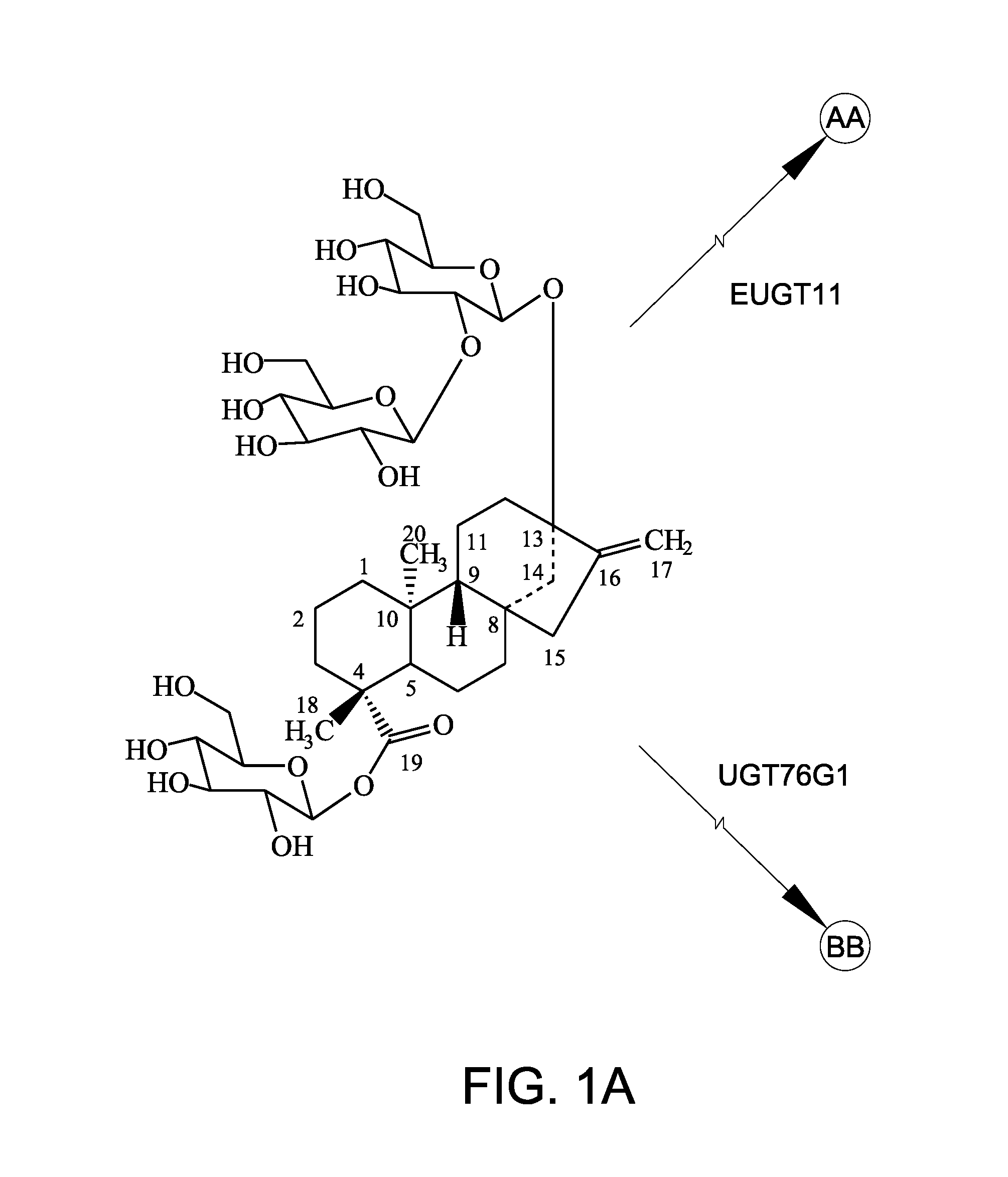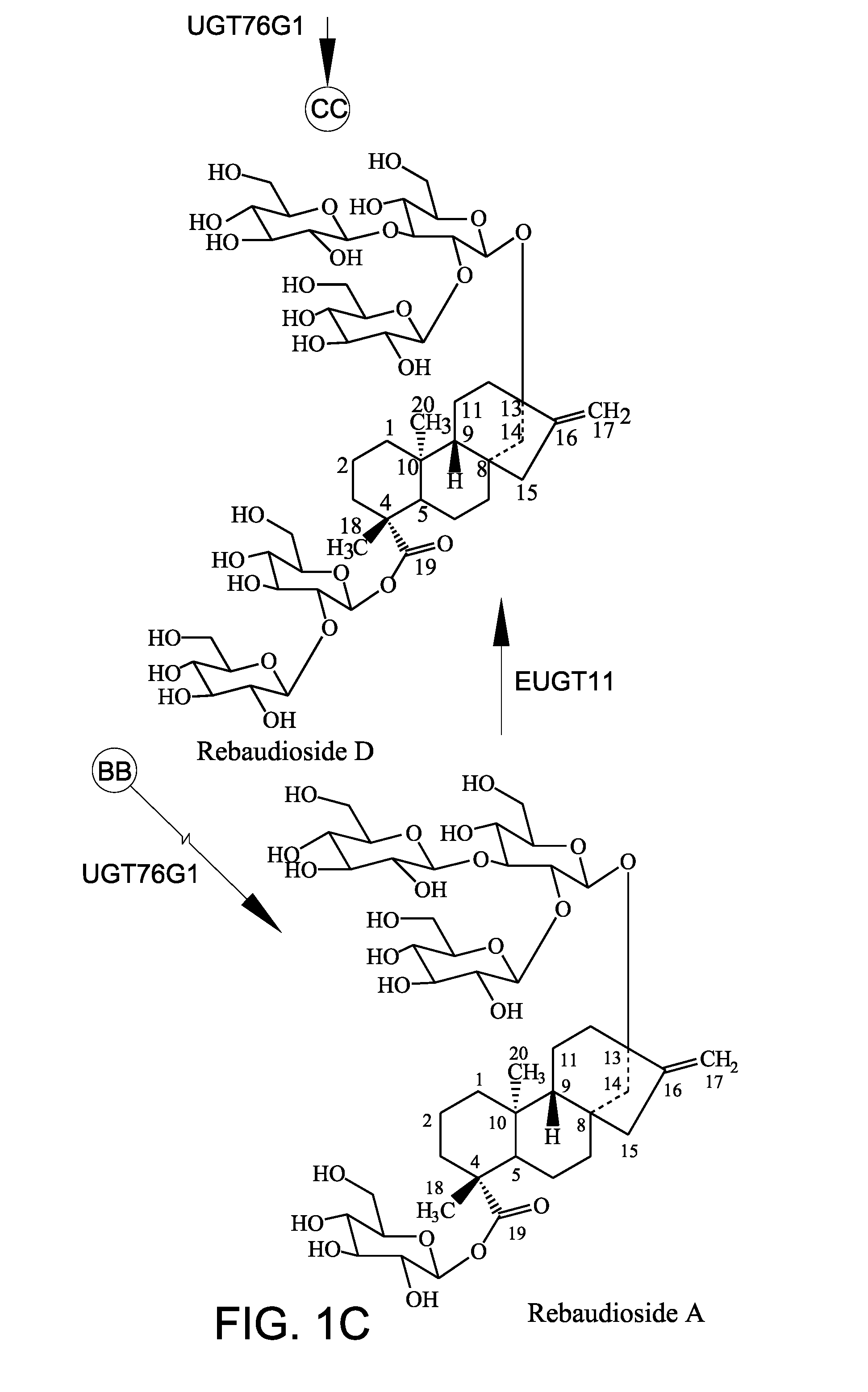Non-caloric sweetener
a non-caloric, sweetener technology, applied in the field of natural sweeteners, can solve the problems of undesirable taste attributes of widespread use of stevia, dulcin, sodium cyclamate and saccharin, and many artificial sweeteners such as dulcin, etc., and achieve the effect of enhancing the sweetness of the beverage produ
- Summary
- Abstract
- Description
- Claims
- Application Information
AI Technical Summary
Benefits of technology
Problems solved by technology
Method used
Image
Examples
example 1
[0145]In this Example, full-length DNA fragments of all candidate UGT genes were synthesized.
[0146]Specifically, the cDNAs were codon optimized for E. coli expression (Genscript, Piscataway, N.J.). The synthesized DNA was cloned into a bacterial expression vector pETite N-His SUMO Kan Vector (Lucigen). For the nucleotide sequence encoding the UDP-glycosyltransferase fusion enzyme (EUS) (see, SEQ ID NO:6), a GSG-linker (encoded by the nucleotide sequence: ggttctggt) was inserted in frame between a nucleotide sequence encoding the Oryze sativa uridine diphospho glycosyltransferase (EUGT11) domain (see, SEQ ID NO:2) and the nucleotide sequence encoding the A. thaliana sucrose synthase 1 (AtSUS1) domain (see, SEQ ID NO:4). Table 2 summarizes the protein and sequence identifier numbers.
TABLE 2Sequence Identification Numbers.NameSEQ ID NODescriptionEUGT11SEQ ID NO: 1Amino acidEUGT11SEQ ID NO: 2Nucleic acidAtSUS1SEQ ID NO: 3Amino acidAtSUS1SEQ ID NO: 4Nucleic acidEUS fusion enzymeSEQ ID NO...
example 2
[0149]In this Example, recombinant EUGT11 protein and recombinant EUS fusion enzyme were assayed for 1,2-19 O-glucose glycosylation activity using rebaudioside A as the steviol glycoside substrate.
[0150]The recombinant polypeptides (10 μg) were tested in a 200 μL in vitro reaction system. The reaction system contained 50 mM potassium phosphate buffer, pH 7.2, 3 mM MgCl2, 1 mg / ml steviol glycoside substrate, and 1 mM UDP-glucose. The reaction was performed at 30° C. and terminated by adding 200 μL of 1-butanol. The samples were extracted three times with 200 μL of 1-butanol. The pooled fraction was dried and dissolved in 70 μL of 80% methanol for high-performance liquid chromatography (HPLC) analysis. Rebaudioside A (purity 99%) was used as the substrate. Rebaudioside A was obtained from Blue California (Rancho Santa Margarita, Calif.). In vitro reactions were carried out for 14 hours and 24 hours. FIG. 3A shows the peak for rebaudioside D (labeled “Reb D”) for comparison.
[0151]The U...
example 3
[0154]In this Example, EUGT11 and EUS were assayed for 1,2-19 O-glucose glycosylation activity using stevioside as the steviol glycoside substrate at incubation times of 14 hours and 24 hours as described in Example 2.
[0155]In addition to the conversion of rebaudioside A to rebaudioside D by EUGT11 as discussed in Example 2 above, EUGT11 also converted stevioside to rebaudioside E (labeled “Reb E” in FIG. 4). Surprisingly, an unexpected compound, rebaudioside D2 (labelled “Reb D2” in FIG. 4), having a HPLC retention time of about 7.28 minutes was produced by both EUGT11 and EUS in all reactions. When AtSUS1 was added to the EUGT11 reaction mixture to create the UGT-SUS coupling system (FIGS. 4D and 4G) and when EUS was used (FIGS. 4B and 4E), more rebaudioside D2 was produced. Along with the increase in rebaudioside D2 production, rebaudioside E (labeled “Reb E” in FIGS. 4C and 4F) that was produced was consumed during the production of the rebaudioside D2. These results indicated t...
PUM
| Property | Measurement | Unit |
|---|---|---|
| pH | aaaaa | aaaaa |
| pH | aaaaa | aaaaa |
| pH | aaaaa | aaaaa |
Abstract
Description
Claims
Application Information
 Login to View More
Login to View More - R&D
- Intellectual Property
- Life Sciences
- Materials
- Tech Scout
- Unparalleled Data Quality
- Higher Quality Content
- 60% Fewer Hallucinations
Browse by: Latest US Patents, China's latest patents, Technical Efficacy Thesaurus, Application Domain, Technology Topic, Popular Technical Reports.
© 2025 PatSnap. All rights reserved.Legal|Privacy policy|Modern Slavery Act Transparency Statement|Sitemap|About US| Contact US: help@patsnap.com



